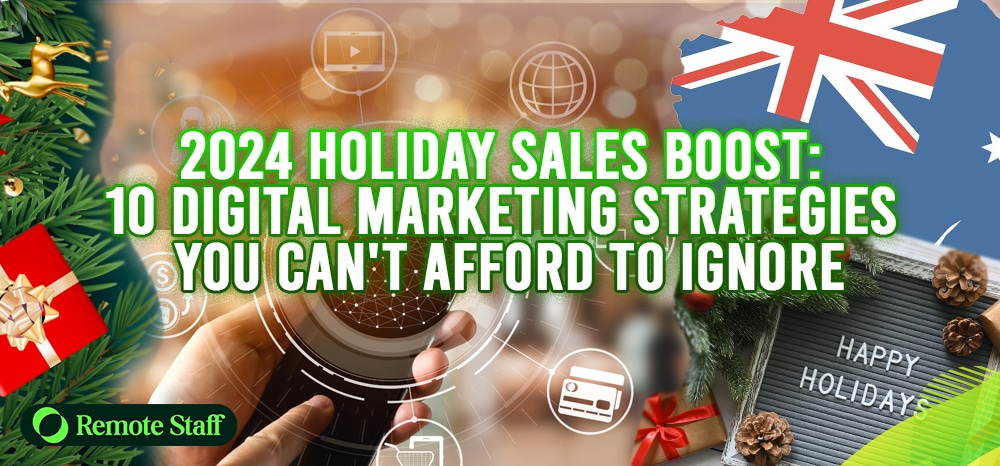In Australia, the holiday season is all about relaxing, catching up, and gift-giving – which means more shopping!
Now that the holiday rush is almost here, it’s the perfect time for businesses to boost year-end sales by tapping into all the festivities, Christmas wish lists, and last-minute shopping!
Let’s take a look at actionable strategies for how brands can use this opportunity to maximise sales and roll out their best campaigns.
Understanding the Holiday Shopping Landscape in Australia for 2024
Studies show that Aussies often shop online before visiting brick and mortar stores. In fact, around 53% of consumers plan to finalise their shopping lists by October, and 58% aim to complete most of their purchases by late November.
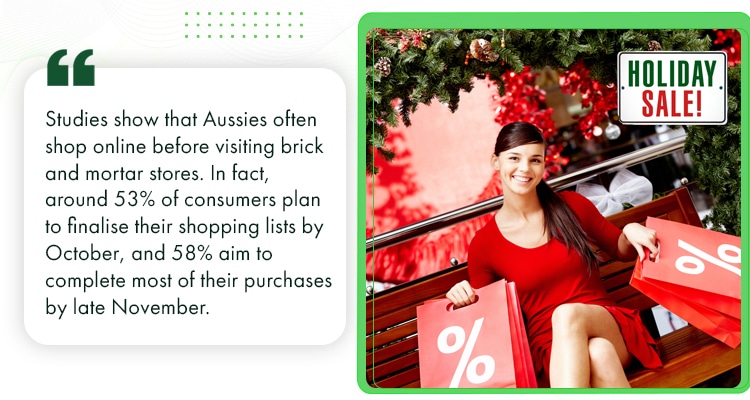
As holiday spending peaks, retailers are likely to see high engagement across both e-commerce platforms and brick-and-mortar stores. There’s also a rising demand for personalised shopping experiences, driven by the growth of artificial intelligence (AI) and virtual shopping assistants.
Holiday Shopping Trends and Consumer Behaviour
As the holidays approach, businesses are noticing these holiday trends and shifts among Australian consumers in 2024:
- Online Shopping Dominance – Instead of braving last-minute crowds in physical stores, most consumers now prefer to browse and buy gifts online from the comfort and security of their homes using their mobile devices.
- Focus on Sustainability – Many Australians are now more aware of the environmental impact of their shopping. Younger shoppers, in particular, are opting for sustainable products and eco-friendly packaging.
- Social Media Influence – Instagram and TikTok play a major role in holiday shopping decisions. Hence, many brands are tapping influencers to connect with audiences and inspire gift ideas.
Importance of Early Planning for Australian Businesses
The holiday rush is a great chance for businesses to connect with their target audience and offer value-driven products and services. However, early planning is key to take full advantage of this opportunity.
Holiday retail sales are pretty competitive, so companies that plan ahead can align their marketing, manage inventory, and engage customers more effectively. Moreover, early planning allows brands to analyse past holiday performance, identify trends, and better forecast future demands in preparation.
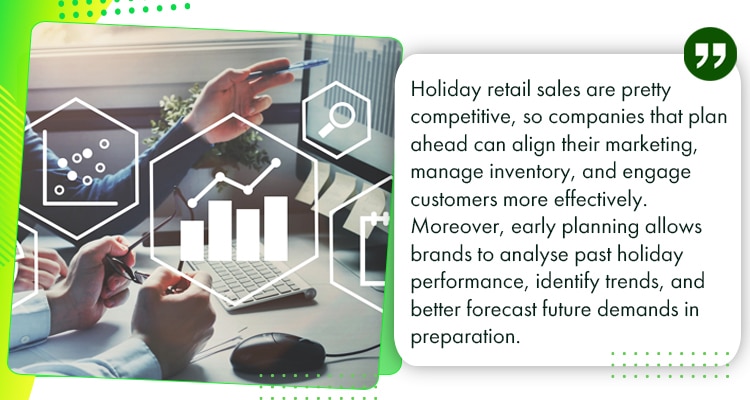
So, if you’re looking to boost your sales this holiday season, here are 10 digital marketing strategies to help you get started.
Strategy #1: Leverage Early Promotions and Exclusive Pre-Holiday Sales
Pre-holiday sales drive early shopping momentum.
By offering attractive discounts and limited-time deals before the holiday rush, retailers can entice shoppers to buy early and stay ahead of the competition.
Benefits of Early Holiday Promotions
Early promotions help reduce inventory pressure during peak shopping periods, enabling businesses to manage stock levels more effectively. They also:
- Foster goodwill among customers who appreciate the chance to save money;
- Attract consumers looking for the best deals;
- Increase brand visibility and awareness;
- Provide valuable consumer insights; and
- Allow businesses to capitalise on consumer eagerness to shop before the peak season.
Ideas for Exclusive Offers and Loyalty Rewards
Here are some ideas to drive sales for your business this holiday season:
- Holiday Bundles – Curate special holiday bundles that combine complementary products at a discounted price. This makes shopping easier for consumers looking for gift suggestions and also encourages them to spend more.
- Bonus Loyalty Points – Offer extra loyalty points for purchases made during the holiday season. This will not only boost spending frequency but also encourage repeat business, as customers will be motivated by future discounts.
- Early Access to Sales – Give loyal customers early access to holiday sales or special promotions. This exclusive offer makes them feel valued and encourages them to buy before items sell out.
Strategy #2: Optimise Online Presence for Mobile Shoppers
Consumers shop a lot on their phones. So, brands need to ensure their websites and e-commerce platforms are optimised for mobile browsing and shopping.
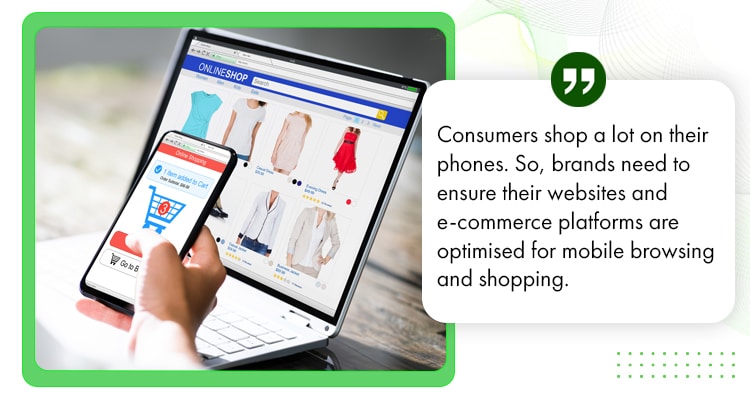
This involves fast-loading pages, simple navigation features, and an easy checkout process to deter cart abandonment. One-click payments, personalised offers, and location-based promotions are also great add-ons.
Mobile Shopping Trends in Australia
Australians rely heavily on their phones, especially for finding the best online deals. Let’s take a look at some key trends:
- Increased Mobile Purchases – Many Australians complete their holiday shopping online. Thus, retailers should invest in mobile-friendly websites and apps to ensure a smooth shopping experience on any device.
- Mobile Payments and Wallets – Consumers are also using digital wallets like Apple Pay and Google Wallet more and more for cashless transactions. Hence, businesses should integrate mobile payment options to make checkout easier and more convenient.
- Social Media Shopping – Platforms like Instagram and TikTok are transforming the way Australians shop. For instance, TikTok’s “yellow baskets” feature lets users shop directly without leaving the app. This trend pushes brands to connect with customers through festive ads, shoppable posts, and influencer partnerships.
Ensuring a Mobile-Friendly Experience
Cultivating a mobile-friendly interface is essential for businesses. Here are some best practices to enhance the customer experience:
- Fast Loading Times – Mobile users get frustrated with slow load times, causing them to abandon their carts and leave the app or website. To avoid this, many online sellers optimise images, reduce redirects, and employ caching to speed up mobile pages.
- Personalised Mobile Experience – Some businesses add personalised features like product recommendations and location-based deals to make the shopping experience more relevant and engaging for each user.
- Clear Calls-to-Action (CTAs) – Lastly, CTAs should be easy to find, simple to tap, and prompt quick decisions. They should also be the right size for touchscreens to make the checkout process easier.
Strategy #3: Personalise Marketing Campaigns with Targeted Content
Personalised content is invaluable for brands looking to connect directly with customers.
For example, personalised emails have higher open rates because they focus on the recipient’s preferences and interests. By addressing the individual directly, these emails feel more valuable and engaging, unlike generic, one-size-fits-all messages that lack personal connection.
Benefits of Personalised Marketing
Many successful businesses use personalised marketing, especially during the holiday season to drive sales further:
- Higher Customer Interaction – Customers feel more engaged with promotional content that feels relevant to their needs. Done right, targeted and personalised marketing increases engagement, clicks, and conversions.
- Enhanced Brand Loyalty – Personalised offers show that brands understand individual needs, which strengthens customer retention. This connection often leads customers to make repeat purchases, especially if they find meaningful deals throughout the year.
- Higher Return on Investment (ROI) – Studies show personalised marketing delivers better results. This is because tailored messages reduce wasted ad spend by ensuring content reaches the right audience at the right time.
Using Data to Customise Offers
Analysing past purchases, browsing habits, and demographics help businesses create offers that align with each customer’s preferences.
This way, companies can better segment their audience and make the right targeted offers. For example, high-value customers might get loyalty discounts, while new customers could receive first-purchase discounts or incentives.
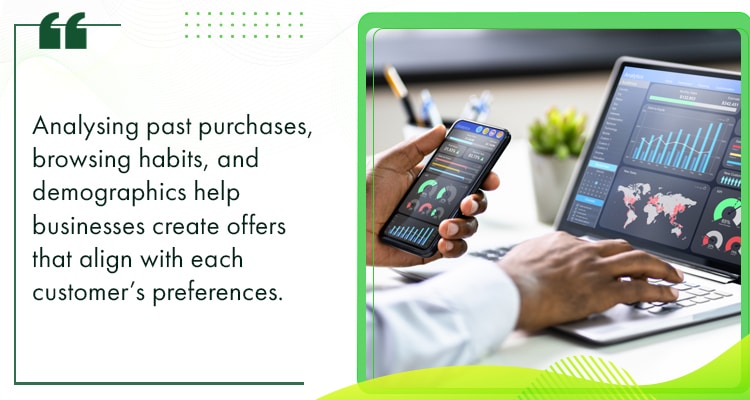
Moreover, data-driven insights allow businesses to suggest products based on customers’ previous purchases or browsing history. This personalised approach makes recommendations more relevant and can encourage additional purchases.
Strategy #4: Use Social Media and Influencer Marketing to Engage Shoppers
Advertising is no longer just for celebrities.
Today, individuals with large or highly engaged social media followings promote brands, products and/or services to help businesses reach their goals. These influencers connect brands with niche audiences, often through relatable and authentic content.
And it works.
Research shows that influencer marketing may be worth AUD $789 million in 2024, highlighting its effectiveness in engaging shoppers, especially during the holiday season.
Influencers share daily life updates, allowing them to subtly promote brands in an authentic, relatable way. Simply put, collaborating with the right influencers boosts a brand’s image by adding an element of authenticity to product recommendations.
Key Social Media Platforms for Holiday Marketing
Campaigns on the following platforms can reach and engage more shoppers this holiday season:
- Instagram – Instagram is perfect for showcasing holiday products through images and videos. You can collaborate with an influencer to post stories or reels promoting your brand’s exclusive deals, limited-time offers, or holiday-themed products.
- TikTok – TikTok’s short-form format also makes it an ideal platform for holiday marketing. Short, creative videos – like trending challenges or influencer collaborations – can increase brand reach and drive conversions when posted at the right time.
- Facebook – Facebook remains a top platform for reaching a broad demographic, despite the rise of Instagram and TikTok. Moreover, its Marketplace feature allows businesses to connect with nearby customers faster, making sales easier.
Tips for Effective Influencer Partnerships
Influencers can greatly boost your brand’s visibility, engagement, and sales. Here are some tips to make the most of these collaborations:
- Choose the Right Influencers – Look beyond their follower count. Instead, partner with influencers who share your brand values and connect well with your target audience.
- Set Clear Goals – Share your objectives, whether it’s increasing brand awareness, driving website traffic, or promoting a holiday sale. This helps influencers understand the campaign’s purpose and how they can contribute to its success.
- Focus on Authentic Content – Encourage them to create genuine, natural content, as their followers can easily spot staged posts. Thus, avoid overly scripted content and give influencers the freedom to connect with their audience in their own unique style.
Strategy #5: Enhance Local SEO to Capture Nearby Shoppers
Optimising your website with location-specific keywords can improve its visibility in local search results. Thus, make sure your website includes accurate details like your address, opening hours, and contact information.
Additionally, encouraging customer reviews, adding location-based content, and creating location-specific landing pages can further improve local rankings.

A strong local search engine optimisation (SEO) presence attracts nearby shoppers and drives foot traffic, especially during busy periods.
Importance of Local SEO for Holiday Sales
Local SEO is essential for businesses that rely on heavy foot traffic or serve customers in specific areas. Here’s why it’s so important:
- Increased Visibility for Nearby Shoppers – Customers often seek conveniently-located stores, especially for last-minute gifts. Thus, improved local SEO makes it easier for potential customers to find local businesses carrying the products they need.
- Improved Google My Business (GMB) Listing – GMB is a free tool that boosts your business’ exposure on Google Search or Maps. Optimising your GMB listing can literally put your business on the map and provide shoppers with your location and special holiday hours.
Best Practices for Google My Business and Local Listings
Here are some best practices to maximise the effectiveness of your GMB listings:
- Verify Your Listing – Claim and verify your GMB to establish ownership. This allows you to manage your business information, respond to reviews, and access insights on customer interactions with your business.
- Use High-Quality Images – Customers often look for images of products, stores, or services when searching online. Hence, high-quality images help your business stand out in the search results to attract more customers.
- Optimise for Keywords – Use relevant local keywords like “best holiday gifts near me” or “Chrismas sales in [your city]” in your business descriptions, service pages, or blog posts. This improves your SEO score and helps your website appear in top search results.
Strategy #6: Offer Flexible and Convenient Payment Options
Consumers expect a smooth checkout process, so many businesses offer payment options like credit cards, digital wallets, and buy-now-pay-later services.
These flexible options make shopping easier, reduce cart abandonment, and attract more customers, especially those who prefer paying in installments.
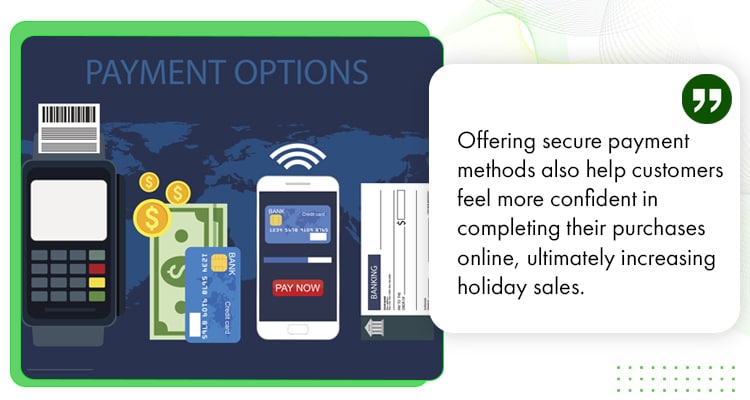
Offering secure payment methods also help customers feel more confident in completing their purchases online, ultimately increasing holiday sales.
Popular Payment Options Among Australian Shoppers
AU shoppers are increasingly seeking secure, flexible, and convenient payment methods. Here are some of the top options:
- Credit and Debit Cards – Traditional credit and debit cards are still the most commonly used payment methods for online shopping in Australia, as they are trusted and widely accepted by businesses.
- Digital Wallets – Apple Pay, Google Pay, and Samsung Pay are becoming more popular for their convenience and security. These options allow customers to make quick, contactless payments, making them ideal for online and in-store transactions.
- PayPal – PayPal remains a popular payment method because of its buyer protection policies, overall payment security, and the ability to link multiple funding sources like credit cards or bank accounts.
Promoting Payment Flexibility in Holiday Marketing
Businesses can attract more customers by offering payment flexibility or discounts for seasonal marketing. Here are some examples:
- Buy Now, Pay Later (BNLP) Options – Some businesses offer BNLP services like Afterpay or Klarna, allowing customers to split payments into manageable installments. This makes larger holiday purchases more affordable for a lot of consumers.
- Time-Limited Promotions – Brands create urgency by offering limited-time discounts or exclusive deals for customers who choose specific payment options. For example, you could offer a discount for purchases made with BNPL services or credit cards.
Strategy #7: Implement a Seamless Omnichannel Experience
An omnichannel strategy uses multiple channels to create a smooth shopping experience. By connecting online and offline touchpoints, you can offer a seamless experience across in-store, online, and mobile app shopping.
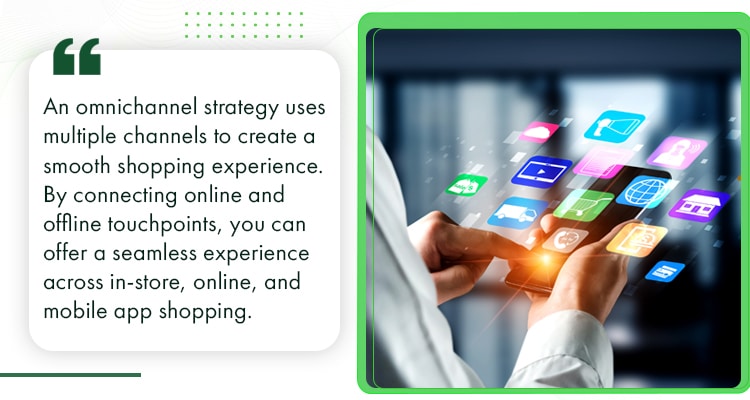
Benefits of Omnichannel Marketing
Omnichannel marketing offers a number of key benefits for brands:
- Enhanced Customer Experience – It allows customers to connect with brands through online stores, physical locations, social media, and mobile apps. This flexibility makes it easy for them to browse or buy products on their preferred channels.
- Improved Data Collection – Omnichannel marketing also enables businesses to gather valuable data on customer behaviour across platforms. These insights help them understand customers better, refine strategies, and enhance marketing efforts.
- Competitive Advantage – Companies with an integrated approach stand out from competitors who operate solely online or in physical stores.
Practical Steps for Integration Across Channels
Integrating channels require careful planning and coordination:
- Centralise Customer Data – Use a Customer Relationship Management (CRM) system to collect and store customer information from all touchpoints. Having a centralised database helps you deliver relevant messages and offers consistently across channels.
- Be Consistent With Brand Messaging – Make sure all marketing content aligns with your brand voice and values. This reinforces your brand identity and builds trust.
- Implement Omnichannel Customer Support – A centralised customer service system can handle support requests from different platforms and retain a history of interactions for easier reference.
- Use Marketing Automation – Take advantage of automation tools to send personalised emails, push notifications, and SMS messages. This ensures timely, relevant communication across channels, like reminders for abandoned carts or holiday promotions.
Strategy #8: Create Urgency with Limited-Time Offers and Scarcity
Customers tend to jump at limited time-offers. By offering exclusive deals for a short period, businesses can encourage customers to buy products before the items sell out.
These tactics are highly effective during the holiday season when shoppers are on the lookout for the best deals. Exclusive discounts tap into the customer’s desire for savings, building a sense of urgency to buy now rather than later.
Psychology of Limited-Time Deals and Scarcity
People are naturally inclined to avoid missing out, and the fear of losing an opportunity often pushes them to act fast.
This is where limited-time deals come in. They create a sense of urgency, prompting consumers to make a purchase before the offer expires. This builds excitement and anticipation, making customers more likely to buy, even if they weren’t planning to.
These tactics work well during the holiday season when customers are focused on buying presents for their loved ones (and for themselves), so most prospects are more primed to purchase than any other time of the year.
Tactics for Urgency-Driven Holiday Campaigns
Here are several tactics you can use for your holiday marketing strategies:
- Early Bird Discounts – Reward customers who shop early with exclusive discounts or gifts. Highlight the limited availability of these deals to drive sales and create a sense of exclusivity.
- Flash Sales and Daily Deals – Launch surprise sales throughout the holiday season to keep customers excited. For example, “Deal of the Day” campaigns offer a new, limited-time deal daily, encouraging customers to keep coming back.
- Low Stock Notifications – Display notifications like “Only 2 left!” on your website, social media, or marketing emails. This tactic uses scarcity to encourage customers to buy before items run out and is particularly effective for bestsellers or limited-edition releases.
Strategy #9: Focus on Sustainability and Ethical Shopping Practices
Australians are becoming more mindful of the environmental impact of their shopping habits. Hence, they are more likely to support brands that focus on eco-friendly products, ethical sourcing, and social responsibility.
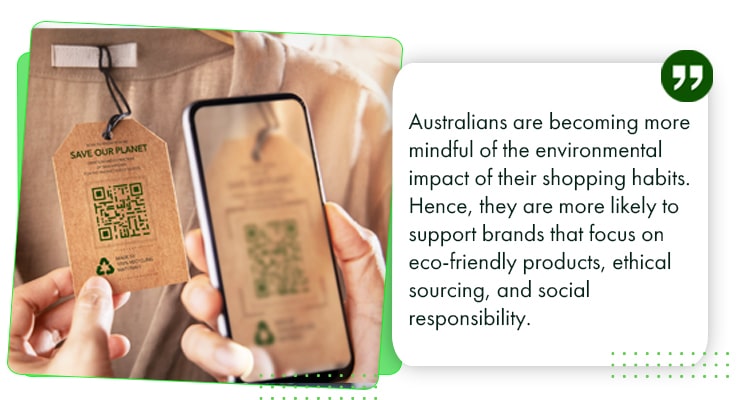
Thus, by offering sustainable products, using eco-friendly packaging, or supporting charitable causes, brands can meet the growing demand for conscious consumerism.
Growing Demand for Sustainable Options
Here’s why shoppers are supporting eco-friendly and socially responsible brands more and more:
- Consumer Awareness – More shoppers are recognising the environmental impact of their purchases. With the growing concerns about climate change, many are opting for sustainable products made from eco-friendly materials.
- Eco-Conscious Millennials and Gen Z Customers – Younger shoppers, especially millennials and Gen Z, prioritise sustainability. In fact, they are willing to pay more for products that align with their values.
- Government Regulations and Certifications – Many governments, including Australia’s, are introducing regulations that encourage businesses to adopt sustainable practices, often offering tax exemptions or incentives in return.
Ideas for Green Marketing Campaigns
There are several green marketing campaigns that can highlight your brand’s commitment to environmental sustainability. These include:
- Eco-Friendly Packaging – Use minimal, recyclable, or biodegradable packaging. Some businesses offer refillable options or take-back programs for packaging recycling. Messaging like “zero waste” can attract consumers concerned about plastic pollution.
- Green Discounts – Offer discounts or incentives for customers who choose eco-friendly products or bring reusable shopping bags. For example, give a 5% discount for customers who bring their containers for refills or present those who opt for digital receipts with a coupon.
- Eco-Friendly Gift Guides – Create holiday gift guides featuring sustainable, ethical, and locally-made products. Promote these guides on your website, social media, and email marketing to attract eco-conscious shoppers during the holiday season.
Strategy #10: Measure and Optimise with Real-Time Analytics
Analytics are essential for identifying which digital marketing campaigns are working and which ones need tweaking. Real-time data, like website traffic, conversion rates, and customer engagement, helps businesses make data-driven decisions.
Based on the data, brands can adjust ad spending, optimise product pages, or personalise content for different segments. This helps them capitalise on peak shopping moments and avoid missed opportunities during holiday campaigns.
Importance of Real-Time Tracking During Peak Shopping Periods
Data monitoring gives businesses immediate insights into customer behaviours, trends, and campaign performance.
Real-time tracking during peak shopping times, like the holiday season, is crucial for maximising sales and customer satisfaction. For example, if a product is trending, you can adjust inventory, boost advertising, and feature it in promotions to capitalise on the demand.
In short, real-time tracking enables brands to act fast and optimise each stage of the customer journey.
Key Metrics and Tools for Quick Insights
The following key metrics help brands make informed, timely marketing decisions:
- Conversion Rates – This metric shows the percentage of visitors who buy your products. Monitoring conversion rates in real time helps you assess if site optimisations, discounts, or promotions are effectively driving sales.
- Cart Abandonment Rate – On the other hand, tracking cart abandonment is essential, especially during peak times. High abandonment rates can indicate issues with the checkout process, unexpected costs, or site performance problems.
- Average Order Value (AOV) – AOV shows the average amount customers spend per transaction. Brands track AOV to see if customers are buying more because of bundle offers or discounts, helping them adjust promotions to increase purchase sizes.
Aside from key metrics, you can also use the following tools to track your marketing campaigns:
- Google Analytics – This platform tracks visitor behaviour, traffic sources, and conversions, providing valuable insights into how users interact with your website.
- Hotjar – Hotjar lets you view heatmaps and session recordings to analyse user interactions. Heatmaps use a colour scale to highlight popular (hot) and less popular (cold) areas of your page, helping you understand user behaviour better.
- Magento Reports – This tool provides e-commerce specific metrics, enabling you to track cart abandonment, inventory levels, and other key performance indicators (KPIs) to optimise your online store.
Frequently Asked Questions (FAQs)
Here are some of the frequently asked questions about holiday digital marketing:
#1. What Metrics Should I Track During the Holiday Season?
As mentioned above, track conversion rates, average order value, and cart abandonment rates to evaluate your marketing campaign’s effectiveness.
Additionally, monitor your inventory levels to avoid overstocking or running out of popular products. Be sure to track real-time traffic sources to identify which channels are driving the most visitors.
#2. Is It Better to Start Holiday Promotions Early or Wait Until December?
The earlier, the better. Consumers are shopping earlier because of stock concerns, early discounts, and the desire to avoid last-minute stress.
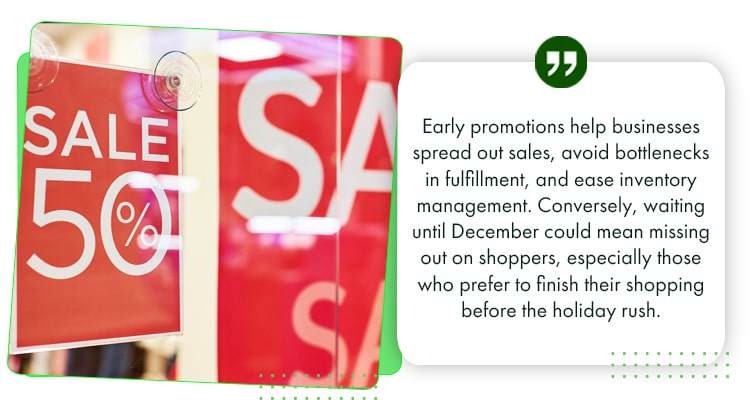
Early promotions help businesses spread out sales, avoid bottlenecks in fulfillment, and ease inventory management. Conversely, waiting until December could mean missing out on shoppers, especially those who prefer to finish their shopping before the holiday rush.
#3. What Eco-Conscious Practices Can Australian Businesses Adopt During the Holidays?
AU businesses can offer digital gift cards or encourage customers to buy digital products to cut down on packaging waste. Some companies partner with local artisans or sustainable brands to promote locally-made products, helping to reduce the carbon footprint linked to shipping.
Furthermore, businesses can implement carbon offset programs, where they invest in projects that reduce or offset their carbon emissions.
Conclusion
With the holiday season fast approaching, brands are rushing to create digital marketing strategies that boost sales, enhance their online presence, and build brand loyalty.
By implementing some or all of these digital strategies, you can make your products and services stand out from the competition. Don’t forget to promote limited-time offers, highlight your sustainable practices, and regularly monitor your campaigns to identify strengths and areas for improvement.
Together, these strategies can help your business make the most out of the holiday season and hopefully end the fiscal year on a good note.
Looking for CX technologies to bring in more sales this holiday season? Click here.
Tap world-class remote workers for your growing business needs during the holidays. Click here.
If you’re ready to experience the full advantages of working with a top global team, check out our 1,000 fully vetted and highly talented staff here.
Syrine is studying law while working as a content writer. When she’s not writing or studying, she engages in tutoring, events planning, and social media browsing. In 2021, she published her book, Stellar Thoughts.

